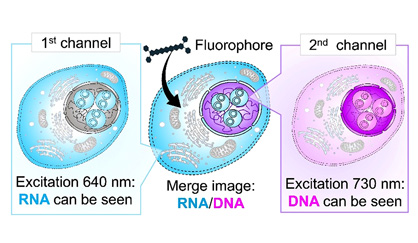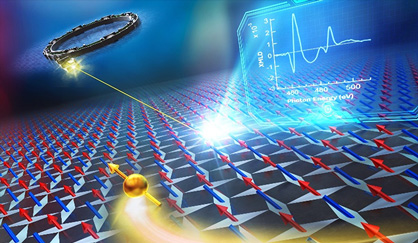High-Precision Analysis of Microstructures in 2D Materials Using Electron Microscopy and Machine Learning
— Nanoscale Imaging of Polarities and Twist Domains in Monolayer MoS2 —2025.08.25
NIMS (National Institute for Materials Science)
A research team led by NIMS has, for the first time, produced nanoscale images of two key features in an ultra-thin material: twist domains (areas where one atomic layer is slightly rotated relative to another) and polarities (differences in atomic orientation). The material, monolayer molybdenum disulfide (MoS2), is regarded as a promising candidate for use in next-generation electronic devices. This breakthrough was achieved by combining scanning transmission electron microscopy (STEM) with artificial intelligence (machine learning), allowing researchers to capture highly detailed nanoscale features over large areas. The research was published in Small Methods on August 6, 2025.
Abstract
Background
Key Findings

Figure. Schematic diagrams illustrating the atomic arrangement of an MoS2 specimen observed using 4D-STEM, showing atomic-scale mapping in real-space coordinates x and y and corresponding diffraction patterns in reciprocal-space coordinates u and v. The analysis revealed the polarity of a twist domain, with red and green indicating opposite polarities.
Future Outlook
Other Information
- This project was carried out by a research team consisting of Koji Kimoto (Group Leader, Electron Microscopy Group (EMG), Center for Basic Research on Materials (CBRM), NIMS; also Director, CBRM), Koji Harano (Principal Researcher, EMG, CBRM, NIMS), Jun Kikkawa (Principal Researcher, EMG, CBRM, NIMS), Ovidiu Cretu (Senior Researcher, EMG, CBRM, NIMS), Yoshiki Sakuma (Special Researcher, Semiconductor Epitaxial Structures Group, Research Center for Electronic and Optical Materials, NIMS), Fumihiko Uesugi (Principal Engineer, Electron Microscopy Unit, Research Network and Facility Services Division, NIMS), Yoshifumi Oshima (Professor, Japan Advanced Institute of Science and Technology (JAIST)), Kohei Aso (Lecturer, JAIST) and Takashi Matsumoto (Group Leader, Tokyo Electron Technology Solutions).
- This work was funded in part by the JSPS Grant-in-Aid for Transformative Research Area (A) under the categories “Supra-ceramics” (grant number: JP22H05145) and “Meso-hierarchy” (grant number: JP23H04874), the JST Strategic Basic Research Program CREST under the category “Fundamental technology for semiconductor-device structures using nanomaterials” (grant number: JPMJCR24A3) and the JSPS Grants-in-Aid for Scientific Research (grant numbers: JP20H02624, JP24K08253, JP17H03241).
- This research was published in the online version of Small Methods on August 6, 2025.
Published Paper
Authors : Koji Kimoto, Ovidiu Cretu, Koji Harano, Fumihiko Uesugi, Jun Kikkawa, Kohei Aso, Yoshifumi Oshima, Takashi Matsumoto, and Yoshiki Sakuma
Journal : Small Methods
DOI : 10.1002/smtd.202501065
Publication Date : August 6, 2025
Contact information
Regarding This Research
Director, Center for Basic Research on Materials
National Institute for Materials Science
TEL: +81-29-860-4402
URL: https://www.nims.go.jp/AEMG/research_E.html (Electron Microscopy Group | NIMS)
URL: https://www.nims.go.jp/AEMG/KMT/KMT_Research_E.html (Advanced transmission electron microscopy and materials characterization | Koji KIMOTO)
Media Inquiries
Division of International Collaborations and Public Relations
National Institute for Materials Science
1-2-1 Sengen, Tsukuba, Ibaraki 305-0047, Japan
TEL: +81-29-859-2026
FAX: +81-29-859-2017
Same Keywords
-
Development of a Model Capable of Predicting the Cycle Lives of High-Energy-Density Lithium-Metal Batteries
(machine learning)
2024.07.24
-
Miniaturization of a Thermoelectric Device Capable of Powering IoT Products
(semiconductor)
2022.06.23
-
Observation of Quantum Transport at Room Temperature
in a 2.8-Nanometer CNT Transistor(semiconductor)
2021.12.24



